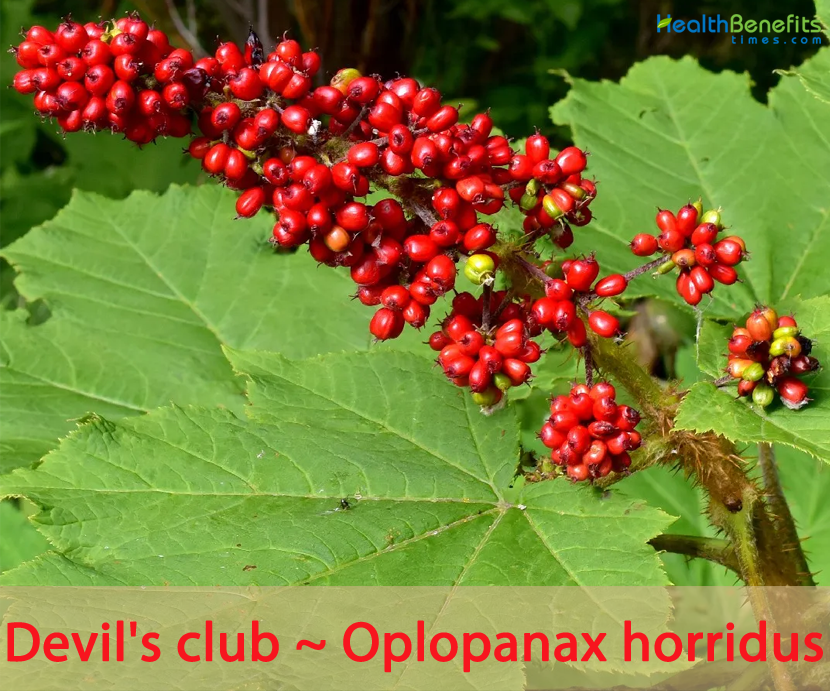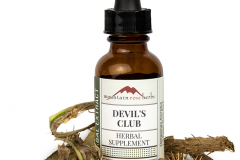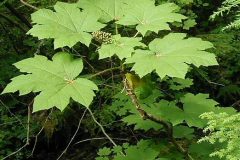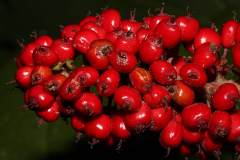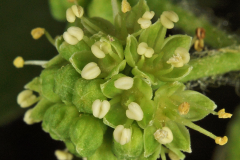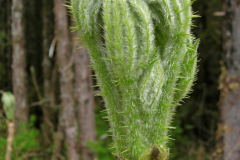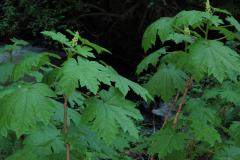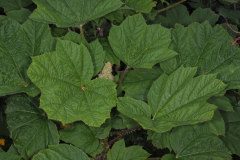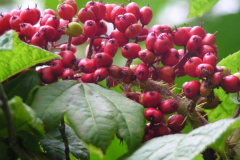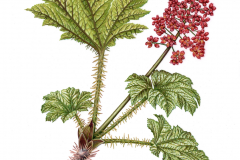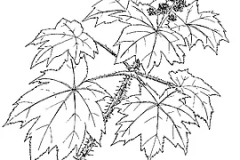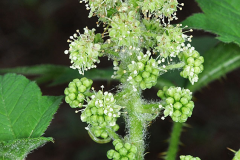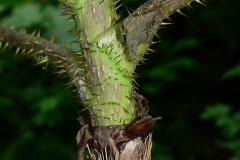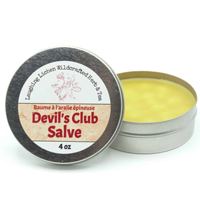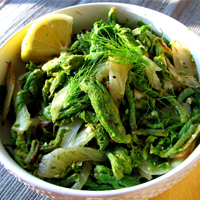| Devil's club Quick Facts | ||
|---|---|---|
| Name: | Devil's club | |
| Scientific Name: | Oplopanax horridus | |
| Origin | South-central Alaska south along the Pacific Coast and the western slope of the Cascade Range to southern Oregon and east to southwestern Yukon Territory, Idaho, and western Montana | |
| Colors | Initially green turning to red as they mature | |
| Shapes | Small round red drupes (a fleshy fruit with a hard pit) about 4 – 7 mm in diameter. They are somewhat flattened and are 5-8 mm long | |
| Taste | Bitter, acrid (slightly), sweet | |
| Health benefits | Cold, cough, sore throat, chest pain, tuberculosis, stomach pain, ulcers, gallstones, indigestion, constipation, influenza, measles, diabetes, cancer, arthritis, and rheumatism | |
| Name | Devil’s club |
|---|---|
| Scientific Name | Oplopanax horridus |
| Native | South-central Alaska south along the Pacific Coast and the western slope of the Cascade Range to southern Oregon and east to southwestern Yukon Territory, Idaho, and western Montana. Disjunct populations occur on several islands of northern Lake Superior, including Isle Royale and Passage Island, Michigan, and Porphyry and Slate islands, Ontario. It may also be found in temperate regions of Northern China, the south of Primorye, northern part of the Korean Peninsula, and Russia, while O. japonicus is endemic to central Japan |
| Common Names | Devil’s club, Devil’s walking-stick, Devilsclub, Alaskan Ginseng |
| Name in Other Languages | Danish: Tornpanax English: Devil’s club, Devil’s walking-stick, Devilsclub, Alaskan Ginseng Finnish: Pirunnuija French: Aralie épineuse, Bois piquant German: Teufelskeule,Teufelsklaue, Igelkraftwurz, amerikanischer Igelkraftwurz Icelandic: Þyrnistokkur Japanese: Amerika hari buki (アメリカハリブキ), Debirusu kurabu (デビルス・クラブ) Polish: Kolcosił straszliwy Russian: Zamanikha (Заманиха), Zamanikha oshtetena (Заманиха ощетиненная) Swedish: Djävulsklubba |
| Plant Growth Habit | Erect to slightly spreading, large understory, deciduous thicket-forming shrub |
| Growing Climates | Moist woods, especially by streams, forest streams, moist soils in the forest and in drainage, seepage, and wet bottom areas |
| Soil | Grows in rich, loamy soils that are consistently moist. It can tolerate seasonal flooding and waterlogged soils. It prefers full shade but can grow in part shade if the conditions are right. It will not grow well in full sun and patches often slowly die when exposed to the forest edge by logging or development. |
| Plant Size | Generally grows to 1 to 1.5 meters (3 ft 3 in to 4 ft 11 in) tall. Some stands located in rainforest gullies or moist, undisturbed areas can reach heights of 3 meters (9.8 ft) to 5 meters (16 ft) or more. The densely thorned stem can reach 3 cm in diameter |
| Bark | Older stems have a gray bark while the younger twigs and buds are reddish brown |
| Leaf | Simple, large palmate leaves (lobed maple-like leaves) with from 5 to 13 lobes on each leaf. The leaves may have spines along the leaf veins on both the upper and lower surfaces. The blades are about 10-35 cm wide and are about as long as the stout petioles |
| Flowering season | June to August |
| Flower | The flowers contain 5 tiny sepals. Individual flowers are very shortly stalked or almost sessile, greenish or white with 5 petals and measures approximately 1/4 of an inch (5-6 mm) in length. The petals are long and loosely twisted. |
| Fruit Shape & Size | Small round red drupes (a fleshy fruit with a hard pit) about 4 – 7 mm in diameter. They are somewhat flattened and are 5-8 mm long |
| Fruit Color | Initially green turning to bright red as they mature |
| Flavor/aroma | Smells fresh and faintly sweet |
| Taste | Bitter, acrid (slightly), sweet |
| Plant Parts Used | Root, lower stem bark, berries |
| Propagation | By seed (which may take two years to germinate), by softwood cuttings or by layering |
| Health benefits |
|
Plant Description
Devil’s club is an erect to slightly spreading, large understory, deciduous thicket-forming shrub that generally grows to 1 to 1.5 meters (3 ft 3 in to 4 ft 11 in) tall. Some stands located in rainforest gullies or moist, undisturbed areas can reach heights of 3 meters (9.8 ft) to 5 meters (16 ft) or more. The densely thorned stem can reach 3 cm in diameter. The thick stems, petioles and leaf veins are generously covered with sharp yellow spines from 5-10 mm long. Older stems have a gray bark while the younger twigs and buds are reddish brown. The plant is found growing in moist woods, especially by streams, forest streams, and moist soils in the forest and in drainage, seepage, and wet bottom areas. The plant grows in rich, loamy soils that are constantly moist. It can tolerate seasonal flooding and waterlogged soils. It prefers full shade but can grow in part shade if the conditions are right. It will not grow well in full sun and patches often slowly die when exposed to the forest edge by logging or development.
Stem
Devil’s Club frequently falls prostrate on the ground and roots from its fallen stems. It also spreads vegetatively through its spreading rhizomes, often producing clonal patches. The stems are all very densely covered with sharp spines that can be very irritating when they pierce the skin. The irritation, once pierced in the skin, can sometimes last for several days.
Leaves
Devil’s Club has simple, large palmate leaves (lobed maple-like leaves) with from 5 to 13 lobes on each leaf. The leaves may have spines along the leaf veins on both the upper and lower surfaces. The blades are about 10-35 cm wide and are about as long as the stout petioles. The leaves have long petioles and are notched at their base where the petiole attaches. They are arranged on the stem spirally and are usually very large, anywhere from 15 – 45 cm across. In the fall its large leaves turn yellow and drop off before winter, returning in early spring the following year.
Flowers
In spring Devil’s Club produces sub-sessile, capitate umbels elongated racemes or panicles. The racemes or panicles grow up to 10 inches (25 cm) in length. The flowers contain 5 tiny sepals. Individual flowers are very shortly stalked or almost sessile, greenish or white with 5 petals and measures approximately 1/4 of an inch (5-6 mm) in length. The petals are long and loosely twisted. Flower has 2 distinct styles and 5 stamens. The 2-celled ovaries are inferior and the stamens are longer than the petals. Flowering normally takes place in between June to August.
Fruit
Fertile flowers are followed by clusters of small round red drupes (a fleshy fruit with a hard pit) about 4 – 7 mm in diameter. They are somewhat flattened and are 5-8 mm long. Each berry consists of 3 seeds. Even though it produces seeds in its drupes, more often it produces populations of clones that grow from spreading rhizomes.
Medicinal Uses of Devil’s Club
| Disease | Medicinal Uses |
| Appetite Stimulant | Infusion of inner bark. |
| Arthritis / Rheumatism | Infusion or decoction of inner bark, pounded leaves and sometimes roots, inner bark used in bath/steam bath, inner bark chewed, crushed root used as poultice, and whole stems used to beat rheumatic limbs as counter-irritant. |
| Birth Control | Decoction of roots. |
| Blood Purifier | Decoction of inner bark. |
| Broken Bone | Decoction of inner bark. |
| Cancer | Infusion of inner bark. |
| Childbirth / Menstruation | Inner bark mashed and swallowed, or decoction of inner bark taken as purgative to expel afterbirth, to start post-partum menstrual flow, regulate menstruation, and for cramps. |
| Diabetes | Infusion or decoction of inner bark and sometimes roots, both alone and in mixtures. |
| Diphtheria | Infusion of roots applied externally. |
| Emetic / Purgative | Decoction or infusion of inner bark prepared in water or seal oil, both alone and in mixtures, roots chewed and the inner bark sometimes swallowed. |
| Fertility | Unspecified |
| Fever | Decoction of inner bark |
| Flu | Infusion of inner bark, alone and in mixtures, and the inner stem bark chewed. |
| Gall Stones | Infusion of inner bark. |
| Hemorrhage and Blood Disorders | Infusion of inner bark, alone and in mixture, and berries pounded into paste taken internally. |
| Heart Disease | Berries pounded into paste taken internally. |
| Insanity | Introduced into the system by beating with stems. |
| Internal Infections | Infusion of inner bark. |
| Laxative | Infusion or decoction of inner bark prepared both alone and in mixtures. |
| Lice and Dandruff | Pounded berries rubbed on hair and scalp. |
| Lymph Trouble (Dropsy) | Ash of inner bark. |
| Measles | Decoction of inner bark. |
| Pain Relief, Analgesic | Decoction of inner bark, inner stem bark mixed with oil and eaten, dried inner bark laid into tooth cavity, steam bath with inner bark. |
| Pneumonia | Decoction or infusion of inner bark, and inner bark used in steam baths with a variety of additional plants. |
| Respiratory Ailments, Coughs, Colds | Decoctions and infusions prepared from inner stem bark, whole stems and sometimes roots, inner bark also chewed, used in sweat baths, and burned and dampened and worn around the neck. |
| Skin Wash | Infusion or decoction of roots used as a general wash for acne, skin disease, dandruff, etc. |
| Sores (Swellings, Cuts, Boils, Burns, and External Infections) | Inner bark, or infusion of, used externally as a poultice or wound dressing or rubbed over sore, dried inner bark pulverized with pitch or burnt to ash and mixed with oil or grease (sometimes salmonberries and dog feces) and applied externally, berries pounded into a paste and applied externally, decoction of root applied externally, and sliver of bark placed in wound to prevent infection. |
| Stomach Trouble / Pains, Ulcers | Infusion or decoction of inner bark or paste made from berries taken internally. |
| Tonic | Infusion or decoction of inner bark or sometimes roots, inner bark chewed, and barks ash infused. |
| Venereal Disease | Decoction prepared from inner bark and whole stems both alone and in mixtures with a variety of other plants. |
| Vision / Blindness | Infusion of inner bark taken internally, inner bark applied externally with pitch, and decoction used as an eyewash to reverse the effects of cataracts |
| Weight Loss | Infusion of de-spined stems. |
Other Medicinal Uses
| Plant Parts | Application | Preparation |
| Inner barks | Respiratory, cardiovascular, gastrointestinal, cold or infection, diabetes, arthritis, and cancer | Decoction; infusion |
| Stem | Respiratory | Decoction |
| Roots | Respiratory, diabetes, and arthritis | Decoction; infusion |
| Berries | Gastrointestinal | Paste |
| Leaves | Arthritis | Decoction; infusion |
Health benefits of Devil’s club
Listed below are some of the popular health benefits of using Devil’s club
1. May reduce inflammation
Devil’s club is often used to treat inflammatory conditions like arthritis, eczema, and psoriasis. Different researches have concluded that the extracts from the leaves of devil’s club reduced multiple markers of inflammation. Leaves were found to contain several antioxidant compounds, including Gallic acid, chlorogenic acid, and protocatechuic acid. More research is needed to determine how devil’s club may affect health and inflammation in humans.
2. Slow cancer cell growth
Although studies in humans are limited, test-tube research concluded that devil’s club may help block the growth of certain types of cancer cells. One test-tube research concluded that a specific compound extracted from devil’s club inhibited the growth of pancreatic cancer cells.
Another test-tube research concluded that the devil’s club extract increased the cancer-fighting activity of chemotherapy drugs like cisplatin and gemcitabine. Still, studies in humans are needed to determine whether devil’s club affects cancer growth when used as a supplement.
3. Arthritis
Devil’s Claw has been studied extensively for the pain relief it can provide to sufferers of arthritis and osteoarthritis. Research was conducted to test the analgesic effects of Devil’s Claw. The results demonstrated that this herb is effective in decreasing knee and hip osteoarthritis pain; however the mechanism by which it does it is not well understood. Devil’s Claw components, called iridoid glucosides, especially harpagoside, may be responsible for its anti-inflammatory effects. Devil’s Claw is also beneficial in decreasing the progression of osteoarthritis by preventing cartilage degradation.
4. Digestive Health
Known as a powerful digestive tonic, the flavonoids and phyto-sterols found in Devil’s Claw are antioxidant, choleretic (stimulate bile production) and antispasmodic which help to maintain overall digestive health. It can provide considerable relief from heartburn as it soothes the inflammation caused by acid reflux. Devil’s Claw can also help in relieving the symptoms of an upset stomach by suppressing inflammation of the stomach.
5. Weight Loss
Research conducted at the University College of Cork in Ireland, has shown that Devil’s Claw can slow down or even stops the production of the “hunger hormone” ghrelin. This herb may be useful for weight loss in suppressing hunger pangs if overeating is a problem, and could make it a promising treatment for “Binge Eating Disorder”. In fact Devil’s Claw is now being investigated for its use as an anti-obesity treatment.
6. Wound Healing
Root of Devil’s Claw can be applied to wounds to stimulate healing. The anti-inflammatory effects of this herb coupled with the pain relief it provides are thought to be responsible for its traditional use as a skin healer.
Traditional uses and benefits of Devil’s Claw
- Stems as well as the root bark of devil’s club possess anti-rheumatic, palliative, anti-phlogistic, appetizing, cathartic, hypoglycemic, emmenagogue, blood purifying, pectoral, ophthalmic and tonic properties.
- An infusion prepared from the herb’s stem and root bark is employed for treating bronchitis, colds and cough, stomach problems, tuberculosis and other problems.
- Decoction is drunk in the treatment of rheumatism and is also applied externally as a wash on the affected joints.
- Poultice of the bark has been used to relieve pain in various parts of the body.
- Poultice of the bark has been applied to a nursing mother’s breasts in order to stop an excessive flow of milk.
- Decoction has been used as an eye wash in the treatment of cataracts and as an herbal steam bath for treating general body pains.
- Burnt stems, mixed with oil, are applied as a salve on swellings.
- An extract of the root bark lowers blood sugar levels and an infusion of the bark has been used in the treatment of diabetes.
- Infusion has a tonic effect on the blood and liver.
- Berries have been rubbed on the scalp to combat lice and dandruff, and to make the hair shiny.
- Devil’s club has been traditionally used to treat a variety of conditions including influenza, measles, diabetes, cancer, arthritis, and rheumatism.
- The plant has been used internally by drinking an aqueous extract of the root or stem bark for the treatment of respiratory ailments (e.g. cold, cough, sore throat, chest pain, tuberculosis) and GI complaints (e.g. stomach pain, ulcers, gallstones, indigestion, constipation).
- Poultices of the inner bark were applied to sores and wounds to prevent or reduce swelling and infection.
- The greenish, inner bark of the roots was chewed or boiled to treat many ailments, including aches and pains (especially due to arthritis), sores and wounds, colds and flu, digestive disorders, lung ailments, cancer, diabetes and before and after childbirth.
- Infusion of inner bark was described as a possible treatment for cancer by indigenous peoples in North America.
- An infusion of bark has been taken as a cold remedy, an analgesic, and treatment for bone ailments.
- An infusion of roots or whole plant has been taken as a cold remedy, tuberculosis remedy, and ulcer treatment.
- Poultice of bark has been used as a boil and ulcer treatment, skin wash, and used to treat wounds, diabetes, lung hemorrhage, and bronchitis.
- Root bark has been chewed as a purgative.
- Dried bark has been used as a deodorant.
- Herbalists in the West mainly use devil’s club for treating respiratory, autoimmune conditions, internal and external infections, eczema, type 2 diabetes, rheumatoid arthritis and sores.
- Some western herbalists also use devil’s club to treat high blood sugar levels and also improve overall health, in addition to a tonic for the pancreas.
Devil’s Club Salve
Ingredients
- Devil’s Club bark, dried
- Olive oil
- Grated beeswax
- Essential oils (optional)
- Vitamin E liquid capsules (optional)
- Jars with lids
- Mesh strainer/cheesecloth
- Large pot or slow cooker
Directions
- Fill a jar with shredded devil’s club bark and cover with olive oil (leaving at least ¼ inch of space at the top).
- Put the lid on the jar, cover in simmering water in a pot or slow cooker and allow infusing 6 hours or overnight.
- Strain the bark from the oil using a fine strainer or cheesecloth.
- To make the salve, pour the infused oil into a pot and heat on low to medium.
- Add grated beeswax (2-4 tablespoons per cup of infused oil) and allow them to melt together.
- At this point, you can add a few drops of your favorite essential oil (optional, but makes it smell nice) and a few drops of liquid vitamin E (also optional, but acts to preserve the salve).
- Stir together, pour into small jars and allow cooling and hardening up.
Devil’s Club Buds with Fennel and Dill
Ingredients
- 3 tablespoons extra-virgin olive oil
- 1/2 large fennel bulb (or one small), cored and thinly sliced
- 3 garlic cloves, minced
- pinch of Aleppo pepper (optional)
- 3 cups Devil’s Club buds/shoots
- zest and juice of 1/2 lemon
- 1 tablespoon fresh dill, chopped
- kosher salt and freshly ground pepper, to taste
Directions
- Clean Devil’s club buds by picking out any twigs or leaves and by washing twice in cold water.
- Fill a large bowl or sink with cold water and several ice cubes.
- Blanch shoots for 2 minutes in a large pot of boiling, salted water.
- Drain and plunge immediately into the cold water. Drain again.
- Lay shoots flat on a kitchen towel.
- Place another towel on top and squeeze out the excess water, or roll the shoots up in the towel and gently squeeze out excess water.
- In a large skillet, sauté fennel in olive oil for 5-7 minutes, until soft and golden brown.
- Add garlic and Aleppo pepper and sauté another 30 seconds.
- Add blanched Devil’s Club buds, stirring until just warmed through and moisture has evaporated from the buds.
- Add lemon zest and juice, and salt and pepper to taste. Serve immediately.
Other Facts
- Berries can be mashed into a pulp and then rubbed onto the scalp to get rid of head lice.
- In many cultures, the plant is believed to possess “magical” powers that impart great strength.
- Berries are inedible for human consumption but are eaten by bears.
- Leaves are eaten by slugs.
- The plant, when planted in dense rows could be used as an effective barrier to prevent livestock or humans from entering the wetland.
- The stems and spines were used to make fish hooks and lures.
- The outer bark of the stems was used as a dye or deodorant.
- Ash of stems was mixed with grease to rub on swellings and to make a reddish brown tattoo paint used by dancers.
- Bark shavings were mixed with different berries to make paint or basket dye.
- The spiny stems were used as protective charms against supernatural powers.
- Devil’s Club was considered an all-around good luck plant!
- Traditionally, the charcoal from the stalks is still used to make ceremonial and protective face paints, and among the Ditidaht and neighboring groups, it was equally significant to red ochre as a symbolic link to the spirit world.
- A piece of Devil’s club hung over a doorway is said to ward off evil.
- In British Columbia, Canada, the smoke of burning plants was used traditionally to drive away disease-causing spirits.
Side effects and risks
People may be at higher risk for an unsafe interaction with devil’s claw if they are:
- Pregnant: Devil’s claw may be unsafe for pregnant people to use and may cause harm to the fetus.
- Breastfeeding: There is not enough evidence for doctors to know whether devil’s claw is safe for people to use while breastfeeding.
- Have low sodium levels: Devil’s claw may reduce a person’s sodium levels, which may worsen symptoms for people who already have low levels of sodium.
- Have diabetes: Devil’s claw may lower a person’s blood sugar level. If a person with diabetes uses it in combination with other medications that lower blood sugar, it may cause blood sugar to drop too low.
- Have heart problems or high or low blood pressure: Devil’s claw may affect heartbeat, heart rate, and blood pressure. It could be harmful to people who have heart and circulatory disorders.
- Have gallstones: Devil’s claw may increase the production of bile, which may be harmful to people with gallstones.
- Have peptic ulcers: Devil’s claw may increase the production of stomach acids, which can worsen stomach ulcers.
- The plant is densely armed with spikes and these spikes are irritant and trigger allergic reactions.
- Consuming devil’s club infusion on a regular basis may also result in excessive weight gain.
- Patient who ingested the diluted extract of the devil’s club inner root bark is known to have suffered from diarrhea.
References:
https://www.itis.gov/servlet/SingleRpt/SingleRpt?search_topic=TSN&search_value=29397#null
https://npgsweb.ars-grin.gov/gringlobal/taxon/taxonomydetail?id=102557
https://pfaf.org/user/Plant.aspx?LatinName=Oplopanax+horridus
https://www.drugs.com/npp/devil-s-club.html#Bloxton.2002
https://gd.eppo.int/taxon/OPOHO
http://www.theplantlist.org/tpl1.1/record/kew-141937
http://nativeplantspnw.com/devils-club-oplopanax-horridus/
https://en.wikipedia.org/wiki/Devil%27s_club
https://www.fs.usda.gov/database/feis/plants/shrub/oplhor/all.html
https://plants.usda.gov/home/plantProfile?symbol=OPHO


